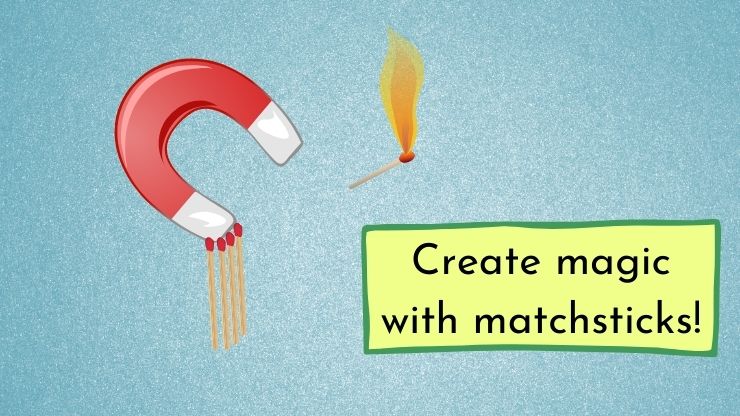Kids love experimenting with magnets. They try to make magnets attract all sorts of things. Pencils, pens, erasers, and whatnot! Kids, have you ever given a thought to a matchstick? Will a magnet attract a matchstick? And why? Let us do a simple magnet and matchstick experiment, and find out more. Of course, there is a matchbox and fire in this experiment. So don’t venture out all alone, take help from your parents!

What we need
Matchsticks (Ones with red head)
Neodymium Magnet
Procedure
- Take out three to four matchsticks from the matchbox.
- Place them together, with all the match heads pointing in the same direction.
- Bring the magnet close to the matchstick heads, and watch what is happening.
- Do you see any visible change to the matchsticks? Are they attracted to the magnet? No.
- Now light one of the matchsticks. Pass it to all the matchsticks. (Please ensure parent supervision for this step. Matchsticks are not to be used by kids without adult supervision)
- When all the matchsticks are burning, put out the fire by blowing them.
- Now you have a set of burnt matchsticks in your hand. Place them together as before.
- Bring the magnet close to the matchsticks. What do you see?
- Matchsticks magically cling to the magnet! Lift the magnet, and you will see the matches still sticking to it.
What we learn
So we saw in this magnet and matchstick experiment that a strong magnet can attract a burnt matchstick, but not an unburnt matchstick. Why does this happen? Before explaining further, let us get a basic idea about how magnets attract things.
Magnetism is caused due to the movement of electrons in the atoms of objects. Every atom has electrically charged particles called electrons spinning around the nucleus. Magnets display a hyperactivity of these electrons, which creates an invisible magnetic field around it. This gives them an ability to attract certain things.
We know that a magnet attracts certain metals such as iron, but it does not attract wood or paper. What is the reason behind this? In most substances such as wood or paper, an equal number of electrons spins in opposite directions. This means that the number of electrons spinning around the nucleus in a clockwise and anticlockwise motion will be the same. This cancels their electric charge.
But in substances such as iron, most of the electrons spin in the same direction, which makes them highly magnetic. If you bring such substances close to a magnetic field, they attract or repel, depending upon the poles.
Now let us come back to our matchstick. The head of a matchstick is made up of several ingredients, such as phosphorus, Sulphur, and carbon. Most red headed matchsticks contain iron oxide too. Iron oxide does not display magnetism. But when we burn the matchstick, iron oxide reacts with carbon to release iron and carbon dioxide. This iron content of the burnt matchstick gets attracted to the neodymium magnet, as it has a very strong magnetic field.
Did you enjoy this experiment? Head to our Experiments section, and you will find more.




